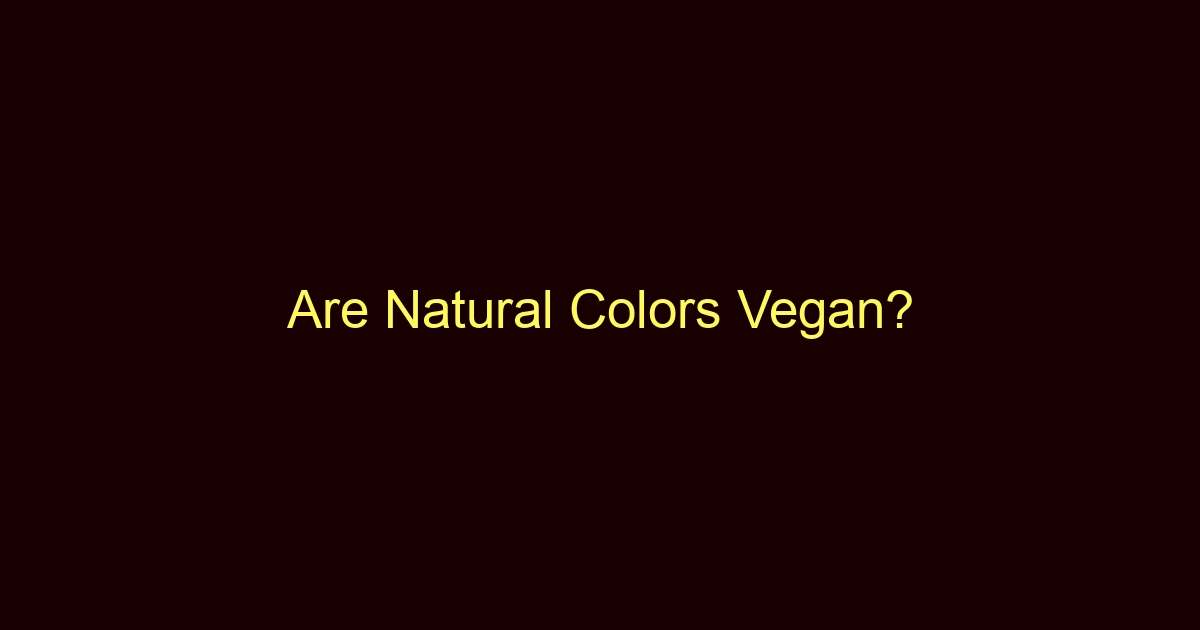From candies to cosmetics, natural colors brighten up numerous products we use daily. With more consumers shifting to vegan lifestyles, the question that often arises is whether these natural colors are vegan. Let’s delve into this.
What are Natural Colors?
Natural colors are dyes or colorants derived from plants, invertebrates, or minerals. The majority of natural colors are vegetable, mineral, or animal-derived, as opposed to synthetic colors which are derived from petroleum or coal tar sources. Natural colors are used in a variety of products including food, beverages, cosmetics, and even clothing.
These colors are seen as a healthier alternative to artificial colors as they are derived from natural sources. While they might not provide as vibrant or lasting colors as their synthetic counterparts, natural colors have seen a surge in demand due to their perceived safety and health benefits.
How are Natural Colors Made?
Natural colors come from a variety of sources. Plant-based colors are obtained from fruits, vegetables, herbs, and spices. Examples include beet juice (red), turmeric (yellow), and spinach (green).
Mineral-based colors come from naturally occurring substances such as iron or titanium, while animal-derived colors are extracted from various parts of animals. A popular example of an animal-derived color is carmine, a vibrant red color obtained from the crushed cochineal insect.
What are Natural Colors Used For?
Natural colors are widely used in food and beverage production, from coloring fruit juices to giving pastries their appetizing hues. In addition to food, they are also used in cosmetics such as lipsticks and blush, and in textile industry for dyeing fabrics.
What Products Contain Natural Colors?
Natural colors can be found in a myriad of products. From the red in your favorite candy, the yellow in your turmeric latte, to the green in your bath bomb, natural colors are everywhere. They are used in a multitude of industries including food and beverage, cosmetics, pharmaceutical, and textile industries.
Are Natural Colors Vegan?
The answer to whether natural colors are vegan is not straightforward and depends largely on the source of the color. Plant and mineral-based colors are generally vegan, as they don’t involve the use of any animal products or byproducts. However, some natural colors are animal-derived and thus not vegan.
For instance, carmine, a commonly used red dye, is made from crushed cochineal insects. Similarly, certain natural colors used in cosmetics could be derived from animal sources, such as guanine (a crystalline material that’s found in crushed fish scales) used for a shimmering or light-diffusing effect in products like mascara and nail polish.
Can Vegans Use Products with Natural Colors and Why?
Vegans can certainly use products with natural colors, provided the colors are derived from plant or mineral sources. They should, however, watch out for products containing animal-derived colors like carmine or guanine.
The use of plant-based colors aligns with the vegan ethos of not using animal products and promotes a cruelty-free lifestyle. However, it’s always advised to check product labels for clarity on the source of the natural colors.
Types of Vegan Natural Colors
Many natural colors used in food and cosmetics are plant-derived, making them suitable for vegans. Beetroot extract provides a vibrant red color, turmeric gives a strong yellow, and spirulina a rich blue or green.
Other plant sources for colors include anthocyanins from berries for red, purple, and blue hues, chlorophyll from leafy greens for green, and beta carotene from carrots for orange. These colors are not just vegan but also carry nutritional benefits from their plant sources.
Challenges with Vegan Natural Colors
While plant-derived colors are vegan and safe, they do pose certain challenges. The vibrancy and stability of natural colors from plants often don’t match up to those of synthetic or certain animal-derived colors.
Factors such as pH, temperature, light, and interactions with other ingredients can cause the colors to change or fade, which is a significant concern in food and cosmetic industries where visual appeal is paramount.
Natural Colors and Sustainability
Using natural, especially plant-derived colors aligns not just with a vegan lifestyle but also with sustainability. Plant sources are renewable, and their cultivation and extraction can have a lower environmental impact compared to synthetic colors derived from petroleum.
However, it’s important to ensure that the sourcing and manufacturing of these natural colors are done ethically and sustainably, without causing deforestation, biodiversity loss, or other environmental harm.
Are Natural Colors Safe?
Natural colors are generally safe for consumption and use. They are subject to regulations by food safety authorities worldwide to ensure they don’t pose a risk to human health. However, some individuals may have allergies or sensitivities to certain natural colors, just like any other food ingredient.
Final Thoughts
In conclusion, while many natural colors are vegan, not all fall into this category. Some natural colors are derived from animal sources and are not suitable for a vegan lifestyle. As consumers, it’s important to read product labels carefully and choose products that align with our dietary preferences and ethical choices.
Plant-derived colors not only offer the vibrancy we desire in our foods, cosmetics, and clothes, but they also align with a cruelty-free and sustainable lifestyle. It’s always recommended to opt for products that are transparent about their ingredients and their sourcing.

